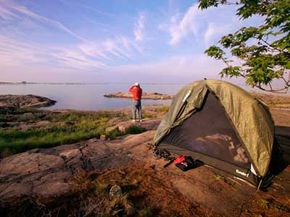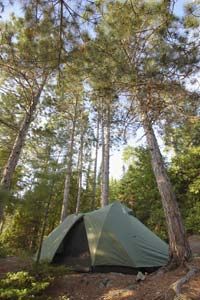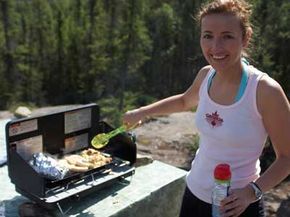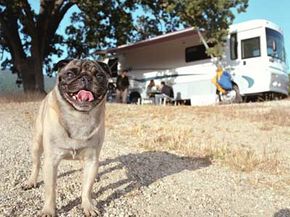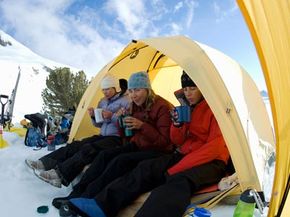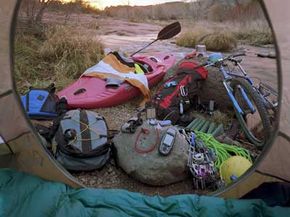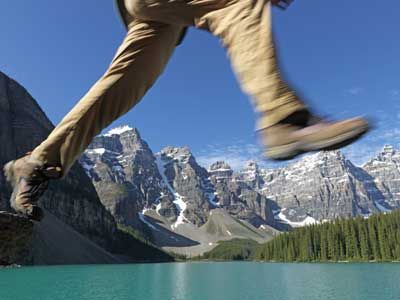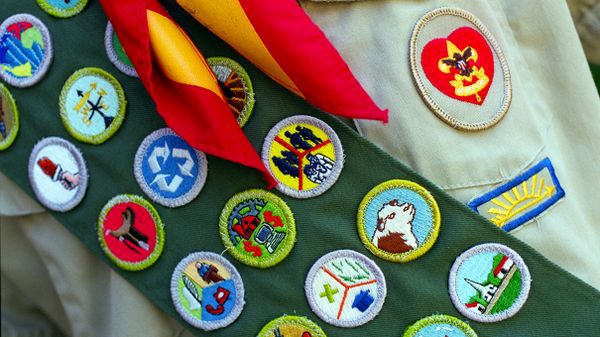If you're new to camping, the first thing you'll need to invest in is a tent and a sleeping bag. Don't worry -- you can find plenty of moderately-priced tents that will protect you against the elements and will last you for years. When choosing a tent, consider that its most important function is to shield you from wind, rain, sun and outdoor pests like mosquitoes and other creatures. A tent also will give you a place to store your gear and provide you with a bit of privacy in the great outdoors. Choose the appropriate size, shape, quality and cost.
Be sure to pick out a tent that will both suit the size of your camping party and be manageable to carry to your campsite. Tents are usually labeled with a maximum capacity. You'll find the number next to the name on the label. If you want to carry only one tent, choose a tent that will accommodate the maximum amount of people you'll camp with. If you're camping solo or with a partner, it's best to pick a two-person tent. Remember that bigger isn't necessarily better. A big tent might be heavy, and it might be hard to find a large enough clearing to set it up.
Most tents come in one of the following shapes:
- Dome tent -- free-standing, meaning that the tent requires no lines. Tension is created when poles are inserted into the pockets of the tent.
- A-frame tent -- beneficial because its sloped walls allow water to slide off
- Walled tent -- shaped like a house, with four walls and an A-frame roof. This tent works well for families because it offers the largest amount of space inside. Depending on its size and your family's size, you might be able to fit everyone in one of these.
- Partial dome tent -- a combination of a walled and a dome tent. The walls of the tent are sloped, and the tent is free standing. But the tent needs to be staked out. It may even have a built-in awning to provide a useful covered area outside the tent. It's a bit more difficult to set up than a dome or A-frame tent, but it gives you extra floor space and higher ceilings.
High quality tents usually have fiberglass or aluminum poles. Lower quality tents usually have plastic poles, which can become brittle over time. Make sure your tent is waterproof -- check that the seams are well-made so that water can't leak through. The tent should include a rain fly, a cover that goes over the main body of the tent. But just because the rain fly is waterproof doesn't mean the ceiling of the tent is. Also, check the zippers to see how easily you'll be able to enter and exit your tent.
Tent costs range based on quality. In general, if you pay less than $100 for your tent, expect to make up for it in set-up hassle and water leaks. To be on the safe side, choose a tent with a lifetime warranty. If you plan to make camping an permanent hobby, consider investing in a more costly tent. If you're just planning on taking a few trips, a less expensive tent without bells and whistles might work for you. High-end tents, at prices around $1,000, may feature amenities like vestibules, two doors, more space and extra vents.
As far as sleeping bags go, you'll want to pick something appropriate for the season in which you're camping. If you're a first-time camper, it's likely you'll camp in the warmer months, so you'll be able to use a lightweight, inexpensive sleeping bag. If you're camping in the winter, however, you'll want to up the ante and invest in something a bit warmer. Sleeping bags come in two basic shapes -- rectangle and mummy. The rectangle bag is like it sounds -- rectangle-shaped. Although it gives you lots of leg room, you should only use this type of bag if you're car camping in the summer months because it's harder to carry in a backpack and doesn't provide as much warmth. The mummy bag, on the other hand, is optimal for cold weather. It provides a close fit, especially around your feet, which preserves body heat. It's also easier to pack this compact bag.
All sleeping bags have a temperature rating provided by the manufacturer. A 50-degree Fahrenheit (10 degrees Celsius) bag is suitable for warm weather camping, while a 0-degree (minus 17 degrees Celsius) bag is better for winter camping. For extreme camping in high altitudes or very low temperatures, choose a minus 10 degree Fahrenheit (minus 23 degrees Celsius) bag. In general, to be safe, always select a bag with a lower temperature range than you expect on your trip in case it's chillier than you thought it would be.
You'll also want to consider the type of material your bag's made of. Down is a great insulator. It's also lightweight, which is an added bonus. But a bag insulated with synthetic materials is non-allergenic and will dry quicker if it gets wet.
